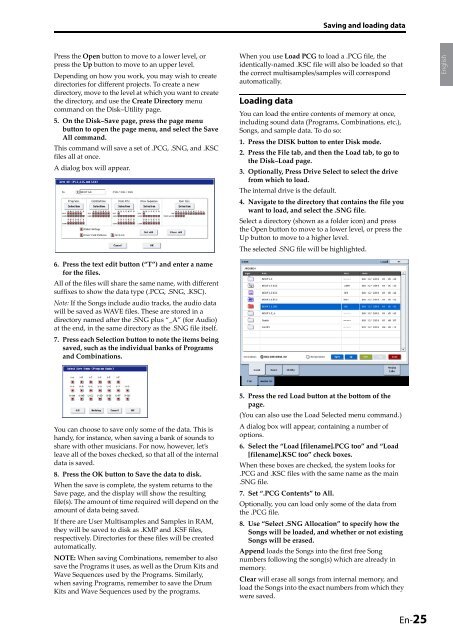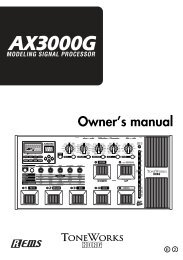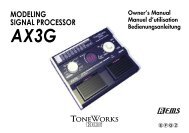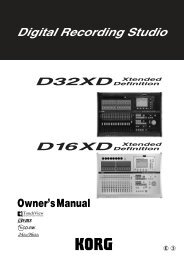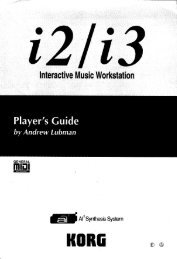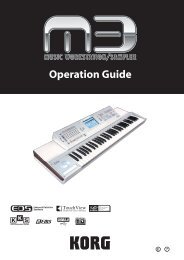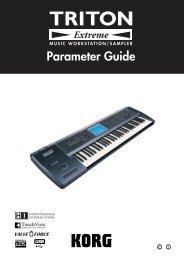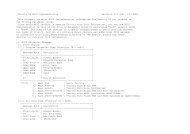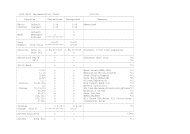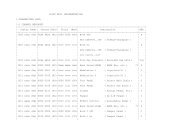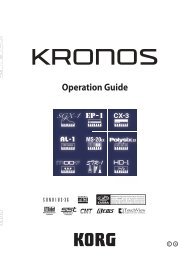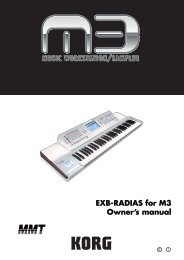Create successful ePaper yourself
Turn your PDF publications into a flip-book with our unique Google optimized e-Paper software.
Saving and loading data<br />
Press the Open button to move to a lower level, or<br />
press the Up button to move to an upper level.<br />
Depending on how you work, you may wish to create<br />
directories for different projects. To create a new<br />
directory, move to the level at which you want to create<br />
the directory, and use the Create Directory menu<br />
command on the Disk–Utility page.<br />
5. On the Disk–Save page, press the page menu<br />
button to open the page menu, and select the Save<br />
All command.<br />
This command will save a set of .PCG, .SNG, and .KSC<br />
files all at once.<br />
A dialog box will appear.<br />
6. Press the text edit button (“T”) and enter a name<br />
for the files.<br />
All of the files will share the same name, with different<br />
suffixes to show the data type (.PCG, .SNG, .KSC).<br />
Note: If the Songs include audio tracks, the audio data<br />
will be saved as WAVE files. These are stored in a<br />
directory named after the .SNG plus “_A” (for Audio)<br />
at the end, in the same directory as the .SNG file itself.<br />
7. Press each Selection button to note the items being<br />
saved, such as the individual banks of Programs<br />
and Combinations.<br />
When you use Load PCG to load a .PCG file, the<br />
identically‐named .KSC file will also be loaded so that<br />
the correct multisamples/samples will correspond<br />
automatically.<br />
Loading data<br />
You can load the entire contents of memory at once,<br />
including sound data (Programs, Combinations, etc.),<br />
Songs, and sample data. To do so:<br />
1. Press the DISK button to enter Disk mode.<br />
2. Press the File tab, and then the Load tab, to go to<br />
the Disk–Load page.<br />
3. Optionally, Press Drive Select to select the drive<br />
from which to load.<br />
The internal drive is the default.<br />
4. Navigate to the directory that contains the file you<br />
want to load, and select the .SNG file.<br />
Select a directory (shown as a folder icon) and press<br />
the Open button to move to a lower level, or press the<br />
Up button to move to a higher level.<br />
The selected .SNG file will be highlighted.<br />
English<br />
Français<br />
Deutsch<br />
You can choose to save only some of the data. This is<br />
handy, for instance, when saving a bank of sounds to<br />
share with other musicians. For now, however, let’s<br />
leave all of the boxes checked, so that all of the internal<br />
data is saved.<br />
8. Press the OK button to Save the data to disk.<br />
When the save is complete, the system returns to the<br />
Save page, and the display will show the resulting<br />
file(s). The amount of time required will depend on the<br />
amount of data being saved.<br />
If there are User Multisamples and Samples in RAM,<br />
they will be saved to disk as .KMP and .KSF files,<br />
respectively. Directories for these files will be created<br />
automatically.<br />
NOTE: When saving Combinations, remember to also<br />
save the Programs it uses, as well as the Drum Kits and<br />
Wave Sequences used by the Programs. Similarly,<br />
when saving Programs, remember to save the Drum<br />
Kits and Wave Sequences used by the programs.<br />
5. Press the red Load button at the bottom of the<br />
page.<br />
(You can also use the Load Selected menu command.)<br />
A dialog box will appear, containing a number of<br />
options.<br />
6. Select the “Load [filename].PCG too” and “Load<br />
[filename].KSC too” check boxes.<br />
When these boxes are checked, the system looks for<br />
.PCG and .KSC files with the same name as the main<br />
.SNG file.<br />
7. Set “.PCG Contents” to All.<br />
Optionally, you can load only some of the data from<br />
the .PCG file.<br />
8. Use “Select .SNG Allocation” to specify how the<br />
Songs will be loaded, and whether or not existing<br />
Songs will be erased.<br />
Append loads the Songs into the first free Song<br />
numbers following the song(s) which are already in<br />
memory.<br />
Clear will erase all songs from internal memory, and<br />
load the Songs into the exact numbers from which they<br />
were saved.<br />
Español<br />
En-25


